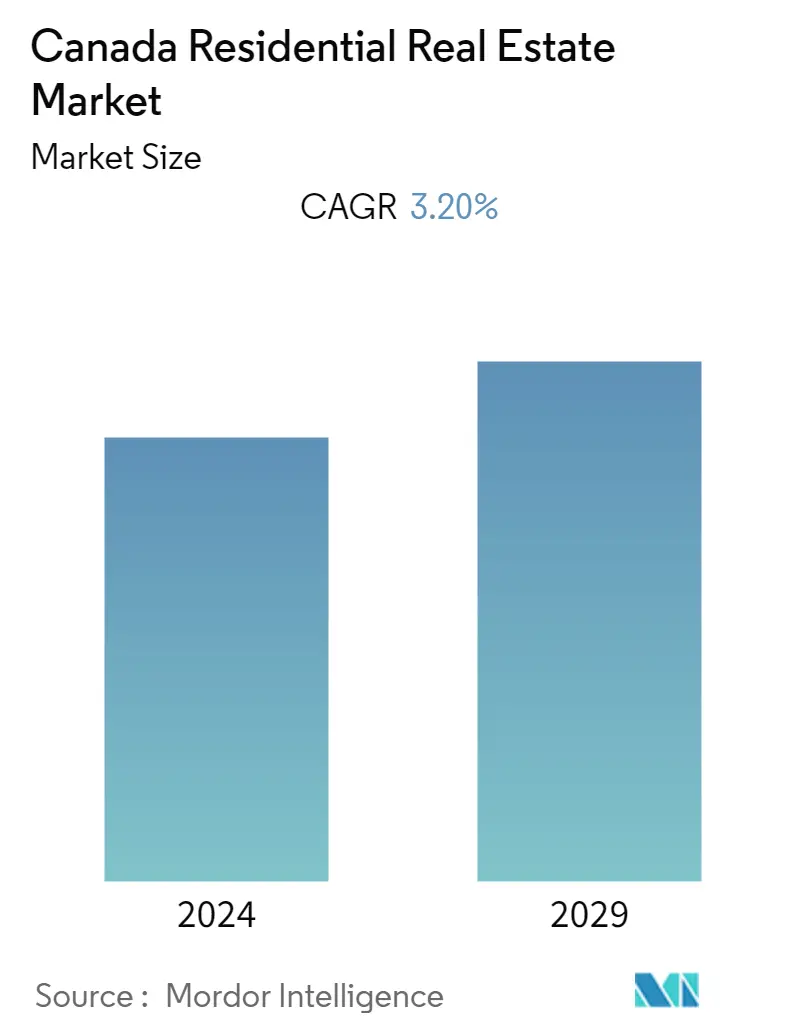Market Size of Canada Residential Real Estate Industry

| Study Period | 2020 - 2029 |
| Base Year For Estimation | 2023 |
| Forecast Data Period | 2024 - 2029 |
| Historical Data Period | 2020 - 2022 |
| CAGR | 3.20 % |
| Market Concentration | Low |
Major Players.webp)
*Disclaimer: Major Players sorted in no particular order |
Need a report that reflects how COVID-19 has impacted this market and its growth?
Canada Residential Real Estate Market Analysis
The Canada Residential Real Estate Market size is expected to grow from USD 59.30 billion in 2023 to USD 69.41 billion by 2028, at a CAGR of 3.20% during the forecast period (2023-2028).
- As Canadian home prices continue to grow across the country, the national average home price broke an all-time high in January 2022. The average home price in Canada's housing market in January 2022 was CAD 748,439 (USD 587,487), up by 20% from 2021. That is the biggest year-over-year price gain in the history of the Canadian housing market. Price patterns for four different types of properties are investigated: new houses, new condominiums, resale houses, and resale condominiums. Before 2020, condominium units grew in value faster than single-family, semi-detached, and row residences. Many changes have occurred in the real estate sector since the outbreak, ranging from virtual tours to a preference for larger homes in the suburbs.
- New Brunswick led the country in terms of the highest Y-o-Y price growth among the provinces, with home prices in New Brunswick up 32% Y-o-Y to CAD 275,000 (USD 215,861) for January 2022. The other Atlantic Provinces trailed behind, with Nova Scotia seeing prices increase by 23% Y-o-Y to CAD 392,828 (USD 308,350), Prince Edward Island with an 18% annual gain to CAD 351,890 (USD 276,216), and Newfoundland & Labrador with a 12% annual gain to CAD 324,800 (USD 254,951). Nationally, sales during January 2022 were down 11% Y-o-Y, while new home listings were down 11% month-over-month.
- As a result, inventories of properties for sale have dropped to historic lows, leaving purchasers with few options. The Bank of Canada kept its overnight rate at 0.25%, where it has been since the beginning of the pandemic, in its January 2022 monetary policy review and said that it expects to keep it there through the middle quarters of 2022.
- Due to COVID-19, builders, and buyers have mostly shifted to virtual tours and digital contract signings. The demand for larger houses has grown as working from home becomes more prevalent. According to the Bank of Canada (BoC), the housing affordability index declined by 15.3% in 2, reflecting less restrictive conditions for homeownership. Since then, it has gradually risen to exceed its pre-pandemic level in Q2 2021. The consumer house-buying power increased at the outset of the pandemic because of lower mortgage rates and higher Household Disposable Income (HDI).
\n
